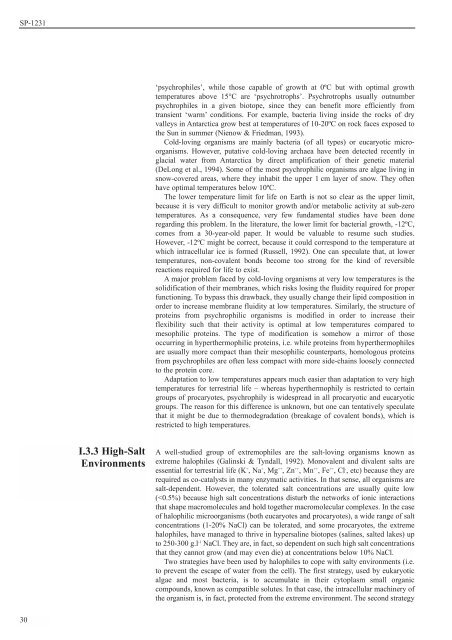Exobiology in the Solar System & The Search for Life on Mars - ESA
Exobiology in the Solar System & The Search for Life on Mars - ESA
Exobiology in the Solar System & The Search for Life on Mars - ESA
Create successful ePaper yourself
Turn your PDF publications into a flip-book with our unique Google optimized e-Paper software.
SP-1231<br />
30<br />
I.3.3 High-Salt<br />
Envir<strong>on</strong>ments<br />
‘psychrophiles’, while those capable of growth at 0ºC but with optimal growth<br />
temperatures above 15°C are ‘psychrotrophs’. Psychrotrophs usually outnumber<br />
psychrophiles <str<strong>on</strong>g>in</str<strong>on</strong>g> a given biotope, s<str<strong>on</strong>g>in</str<strong>on</strong>g>ce <str<strong>on</strong>g>the</str<strong>on</strong>g>y can benefit more efficiently from<br />
transient ‘warm’ c<strong>on</strong>diti<strong>on</strong>s. For example, bacteria liv<str<strong>on</strong>g>in</str<strong>on</strong>g>g <str<strong>on</strong>g>in</str<strong>on</strong>g>side <str<strong>on</strong>g>the</str<strong>on</strong>g> rocks of dry<br />
valleys <str<strong>on</strong>g>in</str<strong>on</strong>g> Antarctica grow best at temperatures of 10-20ºC <strong>on</strong> rock faces exposed to<br />
<str<strong>on</strong>g>the</str<strong>on</strong>g> Sun <str<strong>on</strong>g>in</str<strong>on</strong>g> summer (Nienow & Friedman, 1993).<br />
Cold-lov<str<strong>on</strong>g>in</str<strong>on</strong>g>g organisms are ma<str<strong>on</strong>g>in</str<strong>on</strong>g>ly bacteria (of all types) or eucaryotic microorganisms.<br />
However, putative cold-lov<str<strong>on</strong>g>in</str<strong>on</strong>g>g archaea have been detected recently <str<strong>on</strong>g>in</str<strong>on</strong>g><br />
glacial water from Antarctica by direct amplificati<strong>on</strong> of <str<strong>on</strong>g>the</str<strong>on</strong>g>ir genetic material<br />
(DeL<strong>on</strong>g et al., 1994). Some of <str<strong>on</strong>g>the</str<strong>on</strong>g> most psychrophilic organisms are algae liv<str<strong>on</strong>g>in</str<strong>on</strong>g>g <str<strong>on</strong>g>in</str<strong>on</strong>g><br />
snow-covered areas, where <str<strong>on</strong>g>the</str<strong>on</strong>g>y <str<strong>on</strong>g>in</str<strong>on</strong>g>habit <str<strong>on</strong>g>the</str<strong>on</strong>g> upper 1 cm layer of snow. <str<strong>on</strong>g>The</str<strong>on</strong>g>y often<br />
have optimal temperatures below 10ºC.<br />
<str<strong>on</strong>g>The</str<strong>on</strong>g> lower temperature limit <str<strong>on</strong>g>for</str<strong>on</strong>g> life <strong>on</strong> Earth is not so clear as <str<strong>on</strong>g>the</str<strong>on</strong>g> upper limit,<br />
because it is very difficult to m<strong>on</strong>itor growth and/or metabolic activity at sub-zero<br />
temperatures. As a c<strong>on</strong>sequence, very few fundamental studies have been d<strong>on</strong>e<br />
regard<str<strong>on</strong>g>in</str<strong>on</strong>g>g this problem. In <str<strong>on</strong>g>the</str<strong>on</strong>g> literature, <str<strong>on</strong>g>the</str<strong>on</strong>g> lower limit <str<strong>on</strong>g>for</str<strong>on</strong>g> bacterial growth, -12ºC,<br />
comes from a 30-year-old paper. It would be valuable to resume such studies.<br />
However, -12ºC might be correct, because it could corresp<strong>on</strong>d to <str<strong>on</strong>g>the</str<strong>on</strong>g> temperature at<br />
which <str<strong>on</strong>g>in</str<strong>on</strong>g>tracellular ice is <str<strong>on</strong>g>for</str<strong>on</strong>g>med (Russell, 1992). One can speculate that, at lower<br />
temperatures, n<strong>on</strong>-covalent b<strong>on</strong>ds become too str<strong>on</strong>g <str<strong>on</strong>g>for</str<strong>on</strong>g> <str<strong>on</strong>g>the</str<strong>on</strong>g> k<str<strong>on</strong>g>in</str<strong>on</strong>g>d of reversible<br />
reacti<strong>on</strong>s required <str<strong>on</strong>g>for</str<strong>on</strong>g> life to exist.<br />
A major problem faced by cold-lov<str<strong>on</strong>g>in</str<strong>on</strong>g>g organisms at very low temperatures is <str<strong>on</strong>g>the</str<strong>on</strong>g><br />
solidificati<strong>on</strong> of <str<strong>on</strong>g>the</str<strong>on</strong>g>ir membranes, which risks los<str<strong>on</strong>g>in</str<strong>on</strong>g>g <str<strong>on</strong>g>the</str<strong>on</strong>g> fluidity required <str<strong>on</strong>g>for</str<strong>on</strong>g> proper<br />
functi<strong>on</strong><str<strong>on</strong>g>in</str<strong>on</strong>g>g. To bypass this drawback, <str<strong>on</strong>g>the</str<strong>on</strong>g>y usually change <str<strong>on</strong>g>the</str<strong>on</strong>g>ir lipid compositi<strong>on</strong> <str<strong>on</strong>g>in</str<strong>on</strong>g><br />
order to <str<strong>on</strong>g>in</str<strong>on</strong>g>crease membrane fluidity at low temperatures. Similarly, <str<strong>on</strong>g>the</str<strong>on</strong>g> structure of<br />
prote<str<strong>on</strong>g>in</str<strong>on</strong>g>s from psychrophilic organisms is modified <str<strong>on</strong>g>in</str<strong>on</strong>g> order to <str<strong>on</strong>g>in</str<strong>on</strong>g>crease <str<strong>on</strong>g>the</str<strong>on</strong>g>ir<br />
flexibility such that <str<strong>on</strong>g>the</str<strong>on</strong>g>ir activity is optimal at low temperatures compared to<br />
mesophilic prote<str<strong>on</strong>g>in</str<strong>on</strong>g>s. <str<strong>on</strong>g>The</str<strong>on</strong>g> type of modificati<strong>on</strong> is somehow a mirror of those<br />
occurr<str<strong>on</strong>g>in</str<strong>on</strong>g>g <str<strong>on</strong>g>in</str<strong>on</strong>g> hyper<str<strong>on</strong>g>the</str<strong>on</strong>g>rmophilic prote<str<strong>on</strong>g>in</str<strong>on</strong>g>s, i.e. while prote<str<strong>on</strong>g>in</str<strong>on</strong>g>s from hyper<str<strong>on</strong>g>the</str<strong>on</strong>g>rmophiles<br />
are usually more compact than <str<strong>on</strong>g>the</str<strong>on</strong>g>ir mesophilic counterparts, homologous prote<str<strong>on</strong>g>in</str<strong>on</strong>g>s<br />
from psychrophiles are often less compact with more side-cha<str<strong>on</strong>g>in</str<strong>on</strong>g>s loosely c<strong>on</strong>nected<br />
to <str<strong>on</strong>g>the</str<strong>on</strong>g> prote<str<strong>on</strong>g>in</str<strong>on</strong>g> core.<br />
Adaptati<strong>on</strong> to low temperatures appears much easier than adaptati<strong>on</strong> to very high<br />
temperatures <str<strong>on</strong>g>for</str<strong>on</strong>g> terrestrial life – whereas hyper<str<strong>on</strong>g>the</str<strong>on</strong>g>rmophily is restricted to certa<str<strong>on</strong>g>in</str<strong>on</strong>g><br />
groups of procaryotes, psychrophily is widespread <str<strong>on</strong>g>in</str<strong>on</strong>g> all procaryotic and eucaryotic<br />
groups. <str<strong>on</strong>g>The</str<strong>on</strong>g> reas<strong>on</strong> <str<strong>on</strong>g>for</str<strong>on</strong>g> this difference is unknown, but <strong>on</strong>e can tentatively speculate<br />
that it might be due to <str<strong>on</strong>g>the</str<strong>on</strong>g>rmodegradati<strong>on</strong> (breakage of covalent b<strong>on</strong>ds), which is<br />
restricted to high temperatures.<br />
A well-studied group of extremophiles are <str<strong>on</strong>g>the</str<strong>on</strong>g> salt-lov<str<strong>on</strong>g>in</str<strong>on</strong>g>g organisms known as<br />
extreme halophiles (Gal<str<strong>on</strong>g>in</str<strong>on</strong>g>ski & Tyndall, 1992). M<strong>on</strong>ovalent and divalent salts are<br />
essential <str<strong>on</strong>g>for</str<strong>on</strong>g> terrestrial life (K + , Na + , Mg ++ , Zn ++ , Mn ++ , Fe ++ , Cl - , etc) because <str<strong>on</strong>g>the</str<strong>on</strong>g>y are<br />
required as co-catalysts <str<strong>on</strong>g>in</str<strong>on</strong>g> many enzymatic activities. In that sense, all organisms are<br />
salt-dependent. However, <str<strong>on</strong>g>the</str<strong>on</strong>g> tolerated salt c<strong>on</strong>centrati<strong>on</strong>s are usually quite low<br />
(

















